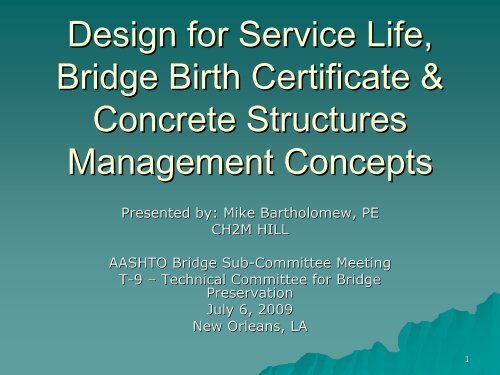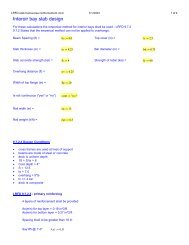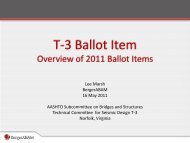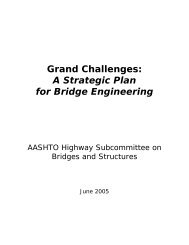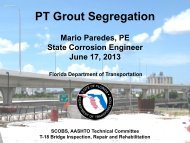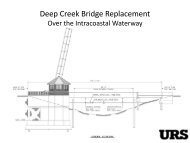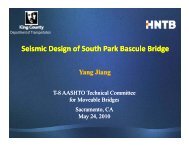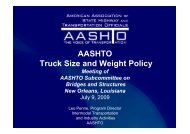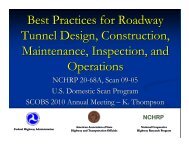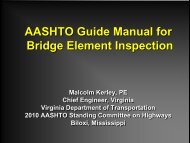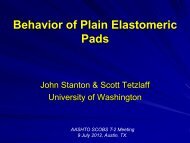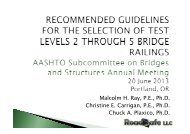Design for Service Life, Bridge Birth Certificate & Concrete ...
Design for Service Life, Bridge Birth Certificate & Concrete ...
Design for Service Life, Bridge Birth Certificate & Concrete ...
Create successful ePaper yourself
Turn your PDF publications into a flip-book with our unique Google optimized e-Paper software.
<strong>Design</strong> <strong>for</strong> <strong>Service</strong> <strong>Life</strong>,<br />
<strong>Bridge</strong> <strong>Birth</strong> <strong>Certificate</strong> &<br />
<strong>Concrete</strong> Structures<br />
Management Concepts<br />
Presented by: Mike Bartholomew, PE<br />
CH2M HILL<br />
AASHTO <strong>Bridge</strong> Sub-Committee Meeting<br />
T-9 – Technical Committee <strong>for</strong> <strong>Bridge</strong><br />
Preservation<br />
July 6, 2009<br />
New Orleans, LA<br />
1
Discussion Topics<br />
<strong>Service</strong> <strong>Life</strong> <strong>Design</strong><br />
– Work Being Done in Europe<br />
– Current US Practice<br />
– Exposure Conditions<br />
– Deterioration Mechanisms / Protection Systems<br />
– Mathematical Modeling<br />
– Limit States / <strong>Design</strong> Process<br />
<strong>Bridge</strong> <strong>Birth</strong> <strong>Certificate</strong><br />
– Purpose<br />
– Documentation Examples & Templates<br />
– Integration with Inventory Management<br />
Systems<br />
2
fédération<br />
internationale du béton<br />
(The International Federation <strong>for</strong><br />
Structural <strong>Concrete</strong>)<br />
Writing new Model Code to include<br />
<strong>Service</strong> <strong>Life</strong> <strong>Design</strong><br />
Publication of 1 st draft scheduled <strong>for</strong><br />
The Third International fib Congress<br />
– Washington, DC<br />
– May 29 to June 3, 2010<br />
3
fib Commission 5:<br />
Structural <strong>Service</strong> <strong>Life</strong> Aspects<br />
Some key areas of interest<br />
– Probabilistic per<strong>for</strong>mance based service<br />
life design.<br />
– <strong>Service</strong> life management.<br />
– Inspection, assessment and<br />
per<strong>for</strong>mance monitoring.<br />
– Development and validation of<br />
deterioration mechanisms.<br />
4
What do these <strong>Bridge</strong>s have in<br />
common?<br />
5
Answer<br />
Although not similar in:<br />
– Structure Type<br />
– Materials<br />
– Age<br />
– Geographic Locations<br />
They are all:<br />
– Deteriorating with time<br />
6
<strong>Service</strong> <strong>Life</strong> (Durability) <strong>Design</strong><br />
fib Bulletin 34 – Model Code <strong>for</strong> <strong>Service</strong><br />
<strong>Life</strong> <strong>Design</strong> (2006)<br />
Establishes design procedures<br />
– to Resist Deterioration<br />
– from Environmental Actions<br />
In 4 Levels of <strong>Design</strong><br />
– Full Probabilistic<br />
– Partial Factor<br />
– “Deemed to Satisfy”<br />
– Avoidance of Deterioration<br />
7
AASHTO LRFD <strong>Service</strong> <strong>Life</strong><br />
(Durability) <strong>Design</strong> Requirements<br />
2.5.2.1.1 – The contract documents<br />
shall call <strong>for</strong> quality materials and <strong>for</strong><br />
the application of high standards of<br />
fabrication and erection.<br />
Structural steel shall be self<br />
protecting or have long-life life coating<br />
systems or cathodic protection.<br />
8
AASHTO LRFD <strong>Service</strong> <strong>Life</strong><br />
<strong>Design</strong> Requirements<br />
C2.5.2.1.1 – The intent of this Article<br />
is to recognize the significance of<br />
corrosion and deterioration of<br />
structural materials to the long-term<br />
per<strong>for</strong>mance of a bridge.<br />
Durability also mentioned in C5.4.2.1<br />
and 5.12.1.<br />
9
AASHTO LRFD <strong>Service</strong> <strong>Life</strong><br />
<strong>Design</strong> Requirements<br />
Expectations <strong>for</strong> durability exist<br />
All recommendations qualify as<br />
“deemed to satisfy” requirements<br />
Code gives no guidance on how long<br />
a structure should remain in service<br />
Lacks models <strong>for</strong> prediction of<br />
deterioration of structures<br />
No metrics to define if a durable<br />
design is achieved<br />
10
<strong>Service</strong> <strong>Life</strong> <strong>Design</strong> Basics<br />
Establishing <strong>Life</strong> Expectancy<br />
Identifying<br />
– Environmental Exposure Conditions<br />
– Deterioration Mechanisms<br />
– Material Resistance to Deterioration<br />
Establishing Mathematical Modeling<br />
Parameters to Predict Deterioration<br />
Setting Acceptable Damage Limits<br />
11
<strong>Life</strong> Expectancy<br />
AASHTO LRFD <strong>Bridge</strong> <strong>Design</strong><br />
Specifications – Section 1.2<br />
– <strong>Design</strong> <strong>Life</strong> – Period of time on which<br />
the statistical derivation of transient<br />
loads is based – 75 years <strong>for</strong> these<br />
Specifications.<br />
– <strong>Service</strong> <strong>Life</strong> – The period of time that<br />
the bridge is expected to be in<br />
operation.<br />
12
What’s s a Reasonable <strong>Service</strong> <strong>Life</strong>?<br />
50, 75, 100, 150 years, … more?<br />
Expected <strong>Service</strong> <strong>Life</strong> is based on<br />
– Owner’s s desires and expectations<br />
Actual <strong>Service</strong> <strong>Life</strong> will depend on<br />
– Exposure conditions of structure<br />
– Quality of materials, design and<br />
construction<br />
– Level of maintenance per<strong>for</strong>med<br />
13
Indicative Values <strong>for</strong><br />
<strong>Design</strong> <strong>Service</strong> <strong>Life</strong> – fib Bulletin 34<br />
<strong>Design</strong> <strong>Service</strong><br />
<strong>Life</strong>, yrs<br />
Examples<br />
10 Temporary Structures<br />
(Structures or parts of structures that can be dismantled with a<br />
view to being re-used are not to be considered temporary)<br />
10-25<br />
Replaceable structure parts, e.g.,<br />
gantry girders, bearings<br />
15-30<br />
Agricultural and similar structures<br />
50 Buildings and other common<br />
structures<br />
100 Monumental buildings, bridges, and<br />
other civil engineering structures<br />
14
<strong>Service</strong> <strong>Life</strong> <strong>Design</strong>ed Structures<br />
Great Belt <strong>Bridge</strong>, Denmark (100<br />
yrs)<br />
15
<strong>Service</strong> <strong>Life</strong> <strong>Design</strong>ed Structures<br />
Confederation <strong>Bridge</strong>, Canada (100<br />
yrs)<br />
16
<strong>Service</strong> <strong>Life</strong> <strong>Design</strong>ed Structures<br />
San Francisco – Oakland Bay <strong>Bridge</strong><br />
(150 yrs)<br />
17
What About These Structures?<br />
Representing the majority of the<br />
600,000+ <strong>Bridge</strong>s in the US<br />
18
Exposure Conditions<br />
19
Site Exposure Conditions<br />
Aggressivity of Environment<br />
– Sea water<br />
– De-icing agents<br />
– Chemical attack<br />
Temperature / Humidity<br />
– Freeze / thaw cycles<br />
– Wet / Dry cycles<br />
– Tropical (every +10º C doubles rate of<br />
corrosion)<br />
20
Member Exposure Conditions<br />
Marine<br />
– Submerged, tidal, splash, atmospheric<br />
zones<br />
Geographic Orientation<br />
– N-S-E-W, seaward, landward<br />
Surface Orientation<br />
– Ponding, , condensation, protection from<br />
wetting, corners<br />
21
Exposure Classes –<br />
European Standard EN-206<br />
206-1<br />
Class<br />
X0<br />
XC1-XC4<br />
XC4<br />
XD1-XD3<br />
XD3<br />
XS1-XS3<br />
XS3<br />
XF1-XF4<br />
XF4<br />
XA1-XA3<br />
XA3<br />
Description<br />
No Risk of Corrosion or Attack<br />
Corrosion Induced by Carbonation<br />
Corrosion induced by chlorides other<br />
than from sea water<br />
Corrosion induced by chlorides from<br />
sea water<br />
Freeze/thaw attack with or without de-<br />
icing agents<br />
Chemical attack<br />
22
Deterioration<br />
Nothing lasts <strong>for</strong>ever<br />
Every material deteriorates at a<br />
unique rate<br />
Deterioration rate is dependent on<br />
exposure conditions<br />
23
Deterioration Mechanisms<br />
Rein<strong>for</strong>ced <strong>Concrete</strong><br />
– Chloride Induced Corrosion<br />
(Seawater, de-icing salts)<br />
– Carbonation Induced Corrosion<br />
(Normal CO 2 from atmosphere)<br />
24
Deterioration Mechanisms<br />
Structural Steel<br />
– Corrosion after Breakdown of Protective<br />
Coating Systems<br />
25
Protection Systems<br />
Material’s s Own Ability to Resist<br />
Deterioration – <strong>Concrete</strong> Quality<br />
(Permeability) and Cover<br />
Protective Coatings<br />
Membranes & Overlays<br />
26
Deterioration Models<br />
27
Chloride Induced Corrosion Models<br />
Fick’s 2 nd Law Models Time to Initiate Corrosion in<br />
Uncracked <strong>Concrete</strong><br />
C crit Cx ( covt , ) C o ( C s , Δx − C o )<br />
⎛ ⎛ cov − Δx ⎞⎞<br />
+<br />
⋅⎜<br />
1 − erf⎜<br />
⎟⎟<br />
⎝ ⎝ 2⋅<br />
D app , C ⋅t<br />
⎠⎠<br />
C(x,t)<br />
erf<br />
C crit<br />
C o<br />
C s,Δx<br />
cov<br />
D app,C<br />
Chloride concentration at depth & time<br />
Mathematical error function<br />
Critical chloride content (to initiate corrosion)<br />
Initial chloride content of the concrete<br />
Chloride concentration at surface or depth Δx<br />
Depth of concrete cover<br />
Apparent coefficient of chloride diffusion in<br />
concrete (permeability)<br />
28
Deterioration Models / Limit States<br />
29
Limit States – Rein<strong>for</strong>ced <strong>Concrete</strong><br />
1 - Depassivation – No damage to<br />
rein<strong>for</strong>cing / end of initiation phase,<br />
corrosion begins<br />
2 - Cracking – Initial expansion of<br />
corrosion by-products<br />
3 - Spalling – Corrosion by-products cause<br />
loss of concrete cover and bond to<br />
rein<strong>for</strong>cing steel<br />
4 - Collapse – Loss of rein<strong>for</strong>cing steel<br />
cross section from corrosion<br />
30
Limit States<br />
Current practice <strong>for</strong> new structures is<br />
Depassivation phase<br />
fib Commission 5 established task<br />
groups on June 18-19, 19, 2009 in<br />
London to better define:<br />
– Critical Chloride Content to cause<br />
rein<strong>for</strong>cing steel depassivation<br />
– Measurable limits <strong>for</strong> cracking, spalling,<br />
and loss of section<br />
31
Structural vs. Durability Issues<br />
<strong>Design</strong><br />
<strong>Design</strong> Work Item<br />
Structural Issues<br />
Durability Issues<br />
Identify Owner’s<br />
Requirements & Desires<br />
Identify Externally Applied<br />
Actions<br />
Select Materials<br />
Determine Dimensions<br />
Summarize Results<br />
Functionality, Capacity (#<br />
lanes), Appearance<br />
Loads (Self weight, Live<br />
Loads, Wind, Thermal,<br />
Seismic, etc.) and Load<br />
Factors<br />
<strong>Concrete</strong> Strength, Steel Yield<br />
& Ductility and Resistance<br />
Factors<br />
Spans, Component cross<br />
sections<br />
Construction Plans &<br />
Specifications, Engineer’s<br />
Cost Estimate, Calculation<br />
Books<br />
Target <strong>Service</strong> <strong>Life</strong><br />
Environmental actions<br />
(chloride attack, carbonation,<br />
freeze-thaw, chemical attack,<br />
etc.)<br />
Chloride diffusion coefficient<br />
in concrete, rein<strong>for</strong>cing steel<br />
type & coating (plain, epoxy<br />
coated, stainless)<br />
Cover dimensions<br />
Durability Report (initiate<br />
<strong>Birth</strong> <strong>Certificate</strong>),<br />
Construction Specifications<br />
(new Diffusion Coefficient<br />
testing), Engineer’s s Cost<br />
Estimate<br />
32
What is Needed to Implement a<br />
<strong>Service</strong> <strong>Life</strong> <strong>Design</strong> Process?<br />
Further Development of<br />
– Deterioration Models (especially <strong>for</strong><br />
Propagation phase)<br />
– Limit States <strong>for</strong> Acceptable Damage (including<br />
critical chloride content)<br />
Creating <strong>Design</strong> Examples / Workshops<br />
Transfer <strong>Concrete</strong> <strong>Service</strong> <strong>Life</strong> <strong>Design</strong><br />
Process to Steel and Other Materials<br />
Get the Attention of FHWA & AASHTO<br />
State <strong>Bridge</strong> Engineers<br />
33
<strong>Birth</strong> <strong>Certificate</strong><br />
fib New Model Code chapter 2, will<br />
define a <strong>Birth</strong> <strong>Certificate</strong>.<br />
A document, report or technical file (depending on the size and<br />
complexity of the structure concerned) containing engineering<br />
in<strong>for</strong>mation <strong>for</strong>mally defining the <strong>for</strong>m and the condition of the structure<br />
after construction. The document / report should provide specific details<br />
on parameters important to the durability and service life of the structure<br />
concerned (e.g. cover to rein<strong>for</strong>cement, concrete permeability,<br />
environmental conditions, quality of workmanship achieved etc) and the<br />
basis upon which future knowledge of through-life per<strong>for</strong>mance should<br />
be recorded. This framework should provide a means of comparing<br />
actual behaviour / per<strong>for</strong>mance with that anticipated at the time of design<br />
of the structure. The document / report should facilitate ongoing<br />
(through-life) evaluation of the service life which is likely to be achieved<br />
by the structure.<br />
34
<strong>Birth</strong> <strong>Certificate</strong> Purpose<br />
Contains engineering in<strong>for</strong>mation<br />
defining <strong>for</strong>m and condition of<br />
structure at end of construction<br />
Documents specific parameters<br />
affecting durability of structure<br />
35
Structural vs. Durability Issues<br />
Construction<br />
Construction Work Item<br />
Structural Issues<br />
Durability Issues<br />
Per<strong>for</strong>m, Monitor & Inspect<br />
Work<br />
Track Variances<br />
Summarize Results<br />
Verify dimensions, test &<br />
document material strength<br />
properties<br />
Accept / Accept with cost<br />
adjustment <strong>for</strong> deficiencies /<br />
Reject<br />
As-Built Plans, Load Rating<br />
Verify and map cover, test &<br />
document actual material<br />
durability properties (chloride<br />
diffusion coefficient, etc.)<br />
Accept / Accept with cost<br />
adjustment <strong>for</strong> deficiencies /<br />
Reject<br />
Durability Rating, update<br />
<strong>Birth</strong> <strong>Certificate</strong><br />
36
<strong>Birth</strong> <strong>Certificate</strong> Purpose<br />
(continued)<br />
Compares actual behavior /<br />
per<strong>for</strong>mance with that anticipated<br />
during design<br />
Facilitates on-going (through-life)<br />
evaluation of remaining service life<br />
37
Structural vs. Durability Issues<br />
In-<strong>Service</strong> Use<br />
Work Item<br />
Structural Issues<br />
Durability Issues<br />
Routine Visual Inspections<br />
(Biennial – required by law)<br />
In-Depth Monitoring (every 7-7<br />
10 years)<br />
Assessment<br />
Rehabilitation/Intervention<br />
Dismantling<br />
To detect obvious defects<br />
with minimal testing<br />
Reactive – Identify problem<br />
areas as they occur (<strong>Concrete</strong><br />
Cracks & Spalls, Rein<strong>for</strong>cing<br />
Corrosion, Joint and Bearing<br />
failure)<br />
Change in Use/Loading or<br />
After Significant Event<br />
(Earthquake, Hurricane,<br />
Flood, Fire, Explosion,<br />
Truck/Ship Impact)<br />
Replace/Repair/Strengthen<br />
damaged structural<br />
components<br />
Demolish & Remove Waste<br />
Same as structural<br />
Proactive – Testing to monitor<br />
in-service conditions (chloride<br />
diffusion coefficient, chloride<br />
profiles, chloride surface<br />
concentration)<br />
Assess Remaining <strong>Service</strong> <strong>Life</strong><br />
of Components<br />
Per<strong>for</strong>m Corrosion Surveys -<br />
Add Corrosion Protection<br />
Systems (Galvanic, Cathodic<br />
Protection, or Electrochemical<br />
Systems)<br />
Recycle & Re-Use Materials<br />
38
<strong>Birth</strong> <strong>Certificate</strong> –<br />
Table of Contents<br />
1) Identification of Asset<br />
– Description & Identification of Structure<br />
– General Plan & Typical Section Drawings<br />
– <strong>Design</strong> Parameters / Target <strong>Service</strong> <strong>Life</strong><br />
2) Environmental Exposure<br />
Conditions<br />
3) Deterioration Models<br />
39
<strong>Birth</strong> <strong>Certificate</strong> –<br />
Table of Contents (continued)<br />
4) Summary of Individual Structure<br />
Components<br />
– Mapping of:<br />
Exposure Classes/Severities<br />
Deterioration Models<br />
Mean Material Properties<br />
Mean Cover Dimensions<br />
Expected <strong>Service</strong> <strong>Life</strong> (Target & Remaining)<br />
40
<strong>Birth</strong> <strong>Certificate</strong> –<br />
Table of Contents (continued)<br />
5) Summary of Ancillary<br />
(Replaceable) Components<br />
– Mapping & Documentation (similar to<br />
Structural Components) <strong>for</strong>:<br />
Bearings<br />
Expansion Joints<br />
Protective Membrane Systems<br />
41
<strong>Birth</strong> <strong>Certificate</strong> –<br />
Table of Contents (continued)<br />
6) In-<strong>Service</strong> Inspection<br />
– Routine & Special Maintenance Schedule<br />
– Schedule of Inspections<br />
Routine Visual (Biennial)<br />
In-Depth Monitoring and Sampling (7-10<br />
years)<br />
– Special Test Method Requirements<br />
7) Dismantling Plan<br />
42
Example <strong>Birth</strong> <strong>Certificate</strong><br />
43
<strong>Birth</strong> <strong>Certificate</strong> – Next Steps<br />
Determine Guidelines <strong>for</strong>:<br />
– Type and number of tests of material<br />
durability properties<br />
– Type and extents of as constructed<br />
concrete cover measurements<br />
Develop templates <strong>for</strong> additional<br />
Deterioration Models <strong>for</strong> the Example<br />
<strong>Birth</strong> <strong>Certificate</strong> (Carbonation)<br />
49
<strong>Birth</strong> <strong>Certificate</strong> – Next Steps<br />
Develop criteria <strong>for</strong> deterioration<br />
models <strong>for</strong> Ancillary Components<br />
(Joints & Bearings)<br />
Develop a suggested <strong>for</strong>mat <strong>for</strong><br />
Inspection & Maintenance Schedule<br />
(similar to automobile maintenance<br />
schedules)<br />
Develop a template <strong>for</strong> a Dismantling<br />
Plan<br />
50
Concluding Remarks<br />
<strong>Service</strong> <strong>Life</strong> <strong>Design</strong> & Inventory<br />
Management<br />
– Addresses the whole life of the structure<br />
– Requires a new proactive mindset <strong>for</strong> the<br />
industry<br />
– Has huge potential <strong>for</strong> predicting the future<br />
health, safety, and allocation of funding of our<br />
infrastructure<br />
Process in its Infancy<br />
– Better prediction tools need to be developed<br />
– But, we need to start somewhere<br />
51
Questions?<br />
Thank you<br />
52


